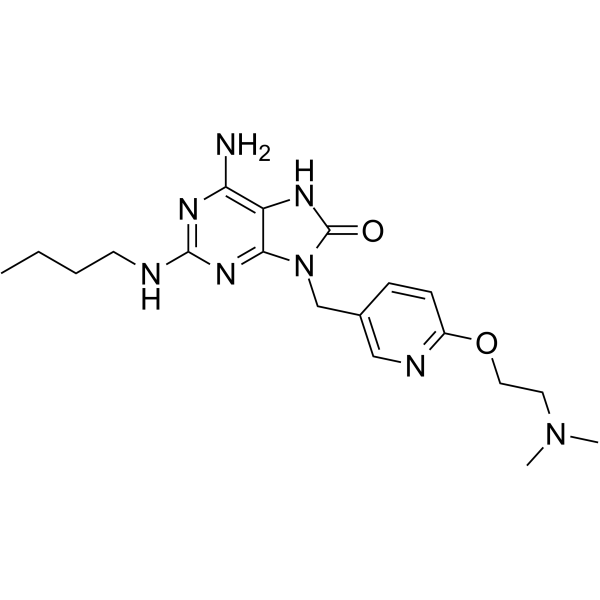
DSR-6434
CAS No. 1059070-10-8
DSR-6434( —— )
Catalog No. M26180 CAS No. 1059070-10-8
DSR-6434 has a strong antitumor effect. DSR-6434 is a potent and selective Toll-like receptor 7 (TLR7) agonist, with EC50s of 7.2 nM and 4.6 nM for human and mice TLR7, respectively.
Purity : >98% (HPLC)
 COA
COA
 Datasheet
Datasheet
 HNMR
HNMR
 HPLC
HPLC
 MSDS
MSDS
 Handing Instructions
Handing Instructions
| Size | Price / USD | Stock | Quantity |
| 5MG | 87 | Get Quote |


|
| 10MG | 149 | Get Quote |


|
| 25MG | 284 | Get Quote |


|
| 100MG | Get Quote | Get Quote |


|
| 200MG | Get Quote | Get Quote |


|
| 500MG | Get Quote | Get Quote |


|
| 1G | Get Quote | Get Quote |


|
Biological Information
-
Product NameDSR-6434
-
NoteResearch use only, not for human use.
-
Brief DescriptionDSR-6434 has a strong antitumor effect. DSR-6434 is a potent and selective Toll-like receptor 7 (TLR7) agonist, with EC50s of 7.2 nM and 4.6 nM for human and mice TLR7, respectively.
-
DescriptionDSR-6434 has a strong antitumor effect. DSR-6434 is a potent and selective Toll-like receptor 7 (TLR7) agonist, with EC50s of 7.2 nM and 4.6 nM for human and mice TLR7, respectively.(In Vitro):To assess the specificity of DSR-6434 toward TLR7, an NF-κB-driven reporter assay is performed in HEK293 cells engineered to express either hTLR7, TLR8 or TLR9. In this assay, successful binding of DSR-6434 to the specific receptor leads to NF-κB activation. DSR-6434 is capable of stimulating reporter gene activity only in HEK293 cells expressing hTLR7 and not in HEK293 cells expressing the structurally similar hTLR8 or hTLR9.(In Vivo):In B6C3F1 mice, DSR-6434 (0.1-1 mg/kg; i.v.) significantly suppresses lung metastasis.
-
In VitroTo assess the specificity of DSR-6434 toward TLR7, an NF-κB-driven reporter assay is performed in HEK293 cells engineered to express either hTLR7, TLR8 or TLR9. In this assay, successful binding of DSR-6434 to the specific receptor leads to NF-κB activation. DSR-6434 is capable of stimulating reporter gene activity only in HEK293 cells expressing hTLR7 and not in HEK293 cells expressing the structurally similar hTLR8 or hTLR9.
-
In VivoDSR-6434 treatment (Compound 20; 0.1-1 mg/kg; intravenous injection; biweekly; for 4 weeks; B6C3F1 mice) suppresses the lung metastasis significantly, 78% inhibition at 0.1 mg/kg dosing (with no tumor metastasis at the 1 mg/kg group). Animal Model:B6C3F1 mice injected with HM-1 ovarian cancer cells Dosage:0.1 mg/kg, 1 mg/kg Administration:Intravenous injection; biweekly; for 4 weeks Result:Suppressed the lung metastasis significantly, 78% inhibition was seen at 0.1 mg/kg dosing (with no tumor metastasis at the 1 mg/kg group).
-
Synonyms——
-
PathwayOthers
-
TargetOther Targets
-
Recptor——
-
Research Area——
-
Indication——
Chemical Information
-
CAS Number1059070-10-8
-
Formula Weight400.487
-
Molecular FormulaC19H28N8O2
-
Purity>98% (HPLC)
-
SolubilityIn Vitro:?DMSO : 125 mg/mL (312.13 mM)
-
SMILESCCCCNc1nc(N)c2[nH]c(=O)n(Cc3ccc(OCCN(C)C)nc3)c2n1
-
Chemical Name——
Shipping & Storage Information
-
Storage(-20℃)
-
ShippingWith Ice Pack
-
Stability≥ 2 years
Reference
1.Goding JW. Conjugation of antibodies with fluorochromes:modifications to the standard methods. J Immunol Methods. 1976;13(3-4):215-26.
molnova catalog



related products
-
NTNCB hydrochloride
NTNCB hydrochloride is an antagonist of neuropeptide Y (NPY) Y5 receptor.
-
Allicin
Allicin exerts antioxidant, bactericidal, anti-cancer, anti-inflammatory activities, it exerts an inhibitory immunomodulatory effect on intestinal epithelial cells.
-
2-undecyloxy-ethanol
2-undecyloxy-ethanol is a monophyllous pheromone that can be used to monitor and control the population of pine saw-toothed beetles.



 Cart
Cart
 sales@molnova.com
sales@molnova.com


